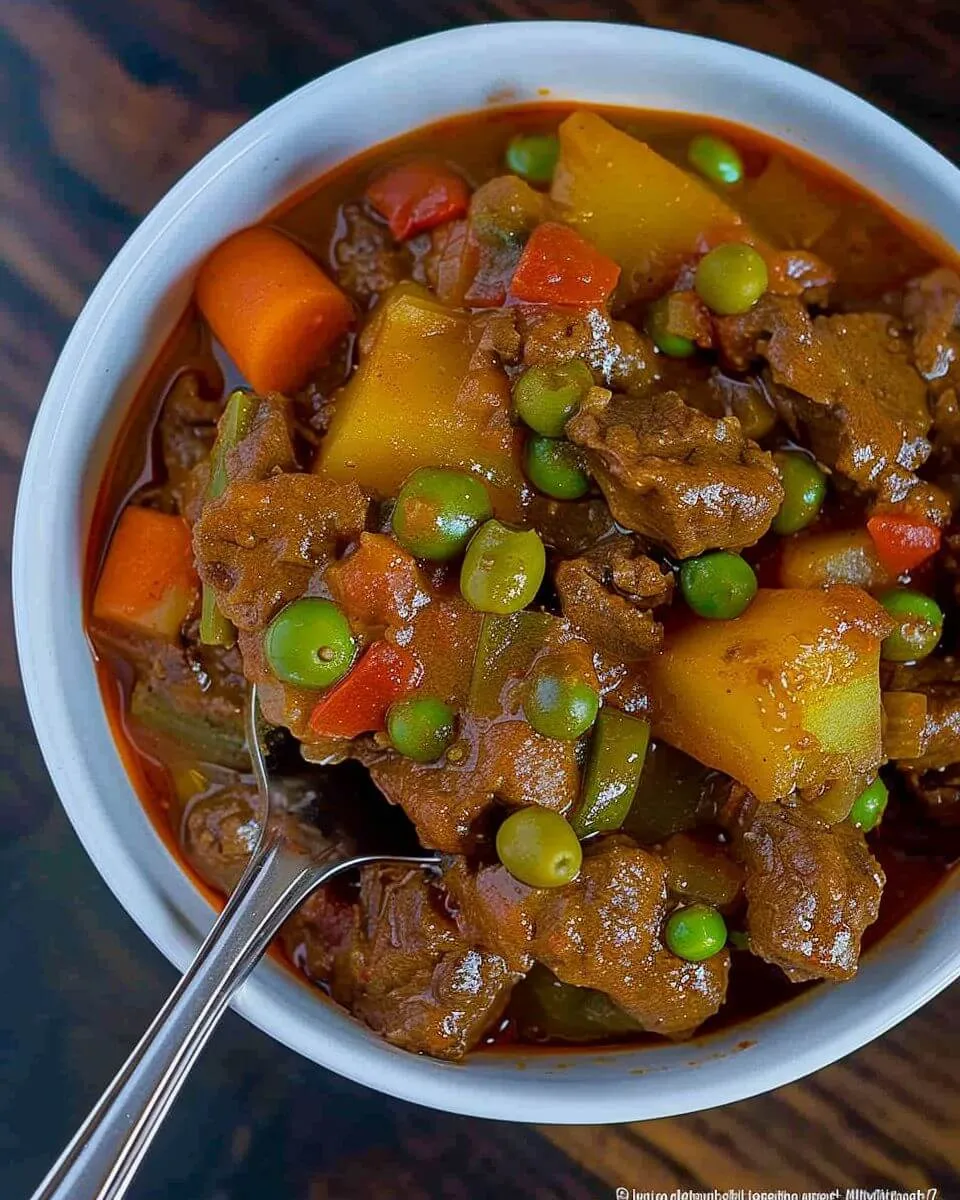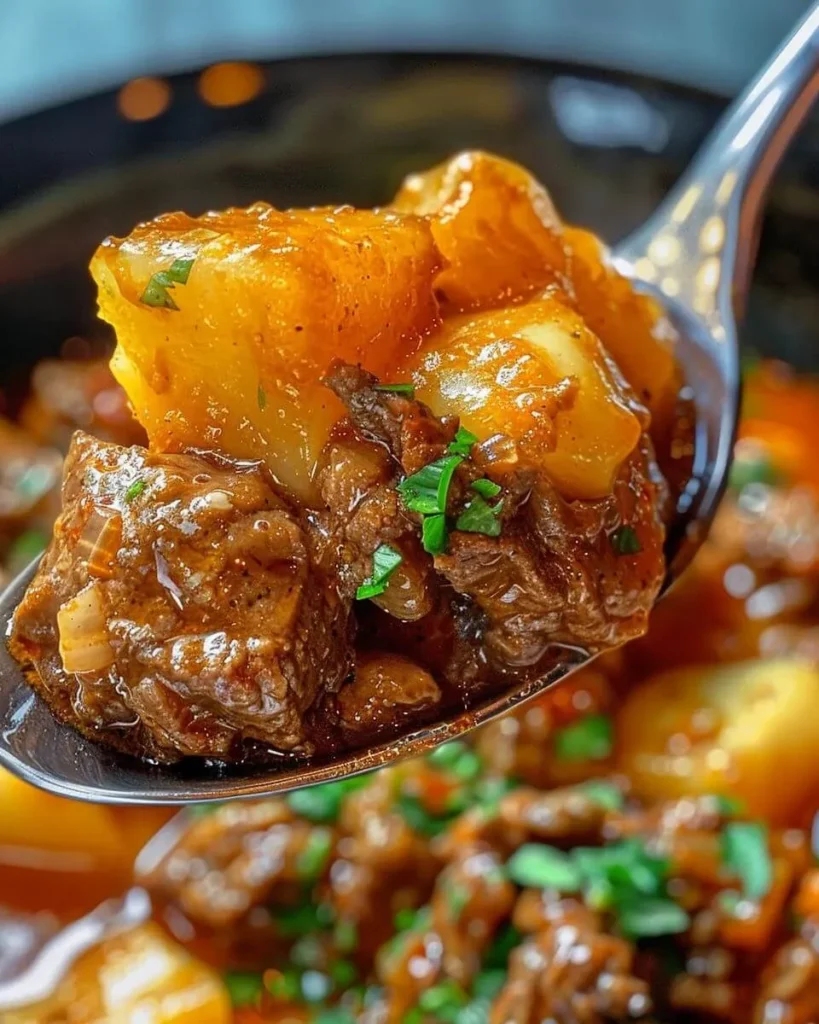Beef kaldereta recipe wasn’t something I grew up with in our busy New York kitchen, but the first time I made it in my Asheville home, it felt instantly familiar. Rich tomato sauce, tender beef, and just the right hint of spice—it reminded me of my Nonna Rosa’s rule: “A good sauce should sing.” This dish? It sings loud and clear.
Since then, this beef kaldereta recipe has become one of my favorite comfort meals. It’s warm, hearty, and full of bold flavors that feel like a hug after a long day. Whether it’s your first time trying kaldereta or you’re chasing a taste of home, this recipe walks you through every step.
And if you love bold, creamy comfort foods, check out my Chicken Alfredo Pasta recipe

Beef Kaldereta (Filipino Stew)
Equipment
- large pot or Dutch oven
- chopping board
- knife
- cooking spoon
Ingredients
- 1 kg beef chuck, cubed
- 2 tbsp cooking oil
- 1 onion, chopped
- 4 cloves garlic, minced
- 1 red bell pepper, sliced
- 1 green bell pepper, sliced
- 2 potatoes, cubed
- 1 carrot, sliced
- 1 cup tomato sauce
- 1 tbsp soy sauce
- 2 cups beef broth or water
- 2 bay leaves
- salt and pepper to taste
- optional: green peas, liver spread, red chilies
Instructions
- Heat oil in a large pot. Sauté onions and garlic until fragrant.
- Add the beef cubes and cook until browned on all sides.
- Pour in the tomato sauce, soy sauce, and beef broth. Add bay leaves. Bring to a boil, then lower heat and simmer for 1.5 to 2 hours or until the beef is tender.
- Add potatoes and carrots. Cook for 10–15 minutes or until vegetables are tender.
- Add bell peppers and optional ingredients (peas, liver spread, chilies). Season with salt and pepper to taste. Cook for 5 more minutes.
- Serve hot with steamed rice and enjoy!
Notes
Nutrition
What is Beef Kaldereta?
The Origins of Kaldereta: A Brief History
The beef kaldereta recipe has a long and flavorful history, rooted in the fusion of cultures. The name “kaldereta” comes from the Spanish word caldera, meaning cauldron—fitting for a stew that simmers patiently, gathering flavor with every passing minute. Brought to the Philippines during Spanish colonization, the technique of stewing meat in tomato-based sauces took on a life of its own as Filipino cooks made it their own.
Beef Kaldereta Recipe Ingredients and Substitutes
What Are the Main Ingredients in Kaldereta?
A good beef kaldereta recipe is built on bold, balanced flavors and simple pantry staples. Below are the core ingredients you’ll need for an authentic version:
| Ingredient | Purpose in Dish |
|---|---|
| Beef (chuck or brisket) | Tender, hearty base protein |
| Tomato sauce | Provides the rich, slightly sweet stew base |
| Liver spread | Adds creamy texture and deep umami flavor |
| Garlic & onions | Foundational aromatics for the sauté base |
| Potatoes & carrots | Classic stew veggies that add bulk and texture |
| Green & red bell peppers | For mild sweetness and color |
| Olives | Slight briny kick to cut through richness |
| Bay leaves | Herbal note to balance the acidity |
| Cheese (optional) | A Filipino twist—adds creaminess at the end |
| Chili (optional) | For those who want it spicy |
| Oil (canola or olive) | Used to sauté the aromatics and sear beef |
| Salt & pepper | Essential seasoning to taste |
This combination creates a stew that’s sweet, salty, tangy, rich, and unforgettable.
Optional Additions and Ingredient Substitutes
Depending on where you are in the U.S., you might need to adjust a few ingredients. No need to worry—this beef kaldereta recipe is easy to adjust and hard to mess up.
Here are smart substitutions that keep flavor intact:
| Original Ingredient | USA-Friendly Substitute |
|---|---|
| Liver spread (Reno or Purefoods) | Liver pâté, chicken liver purée, or liverwurst |
| Tomato sauce (Filipino-style) | Hunt’s Tomato Sauce or San Marzano crushed tomatoes |
| Goat meat (for variation) | Lamb stew meat |
| Beef brisket | Beef chuck, short rib, or shoulder roast |
| Filipino cheese (Eden cheese) | Mild cheddar, Velveeta, or Monterey Jack |
| Filipino chili (siling labuyo) | Thai chili, red pepper flakes, or jalapeño |
| Olives | Capers (for a similar briny punch) |
Don’t be afraid to improvise—cooking is about flavor and heart, not perfection. I’ve made this stew with leftover pot roast, store-brand tomato sauce, and even swapped in sweet potatoes once (surprisingly delicious!).
Looking for something simpler? Try our hearty garlic parmesan cheeseburger bombs—easy, savory, and ready in under 30 minutes.
Choosing the Best Cut of Beef for Kaldereta
Why Beef Chuck or Short Ribs Are Ideal for Stews
To cook the perfect beef kaldereta recipe, choosing the right beef cut is critical. Traditional Filipino cooks swear by beef chuck, brisket, or short ribs—known for their fat-to-meat balance and superb tenderness after long cooking.
| Beef Cut | Best For | Cooking Method |
|---|---|---|
| Chuck Roast | Rich, fork-tender texture | Slow simmer or pressure cook |
| Short Ribs | Meaty, flavorful profile | Braising or stewing |
| Brisket | Deep, beefy taste | Low and slow simmering |
These cuts allow the beef to soak up the kaldereta sauce without drying out, giving you the kind of beef kaldereta that falls apart with a fork.
Discover more beef-based comfort meals in our steak and rice bowl recipe guide.
Step-by-Step Guide to Cooking Beef Kaldereta
Marinating the Beef: Flavor Starts Here
Every great beef kaldereta recipe begins with flavor from within. A simple marinade boosts tenderness and taste—especially if you’re using chuck or brisket.
Quick Marinade:
- 2 tbsp soy sauce
- 1 tbsp calamansi or lemon juice
- 2 garlic cloves, minced
- Black pepper to taste
Marinate the beef for at least 30 minutes—or overnight for deeper flavor. This not only tenderizes the meat but sets it up for a beautiful sear.
Learn more about flavor-packed dishes like our garlic parmesan cheeseburger bombs.
Sautéing Aromatics for Depth
Filipino stews always begin with garlic, onion, and tomato. Sauté until soft and aromatic, then add your marinated beef and brown all sides. This crucial step builds depth by locking in juices and browning the surface, creating that rich, savory base every great beef kaldereta needs.
Simmering Until Perfectly Tender: Techniques That Work
Toss in the potatoes, carrots, and bell peppers during the last 30 minutes to keep them tender, not mushy. Add bay leaves, then cover and simmer.
Cooking Options:
- Stovetop: 1.5 to 2 hours
- Pressure Cooker: ~40 minutes
- Slow Cooker: 6–8 hours on low
Add potatoes, carrots, and bell peppers during the final 30 minutes to prevent overcooking.
Want to elevate your beef kaldereta recipe? Try:
- Grated cheese for creaminess
- Olives or pickle relish for tang
- Chili for heat
If your sauce is thin, remove the lid and reduce it slowly. Or mash a few potatoes for natural thickening.
Check out our gravy recipe guide for thickening tips that work.
Try cloud bread for a light, fluffy side.
Final Adjustments
Before serving, season to taste. Add more liver spread or cheese if needed. Garnish with fresh red bell peppers or chili flakes.

This step-by-step breakdown ensures your beef kaldereta recipe is flavorful, tender, and crowd-pleasing—whether it’s your first try or your family favorite.
Regional Variations of Kaldereta Across the Philippines
Batangas Kaldereta vs. Ilocano Style
Filipinos love to put their own twist on every classic dish, and the beef kaldereta recipe is no exception. In Batangas, it’s all about bold flavors—this version is known for being spicier and more robust, often made with goat meat or beef, lots of liver spread, and hot chilies. Cheese is rarely used, making the sauce taste more earthy than creamy.
Meanwhile, the Ilocano version of kaldereta focuses on saltier, simpler flavors. You’ll find soy sauce used to deepen the umami, along with native vegetables like green peas or local beans. It’s less rich but still hearty.
Both regional takes still use the essential elements of the beef kaldereta recipe—tomato base, beef, liver spread—but the flavor balance shifts based on local taste.
Want the perfect rice pairing for both versions? Don’t miss our flavorful cuban rice bowl.
Beef Kalderetang May Gata (With Coconut Milk)
Another beloved version of the beef kaldereta recipe comes from Southern Luzon, especially Bicol. Here, coconut milk (gata) is added to the stew for a creamier, less acidic flavor. This variation, called Kalderetang May Gata, still follows the classic method—sautéing, simmering, and layering ingredients—but the coconut milk softens the dish and makes it incredibly smooth.
It’s a perfect choice for those who want a rich, tropical twist to their kaldereta. The creaminess also pairs well with spicy versions, balancing the heat with sweetness.
This creamy beef kaldereta recipe is often served during holidays or family gatherings and is especially satisfying with garlic rice or pandesal on the side.
Spicy Beef Kaldereta from Bicol Region
In Bicol, known for its spicy food culture, the spicy beef kaldereta recipe takes the heat up a notch. It’s common to use siling labuyo (bird’s eye chili) in generous amounts, along with optional coconut milk and sometimes even crushed peanuts—giving it a light resemblance to kare-kare, but with a kaldereta base.
This version is popular among spice lovers and often features an extra-thick sauce loaded with grated cheese, chili oil, and liver spread.
Here’s a quick comparison of how regions adjust the classic beef kaldereta recipe:
| Region | Unique Twist | Notes |
|---|---|---|
| Batangas | Extra spicy, no cheese | May use goat or beef |
| Ilocos | Soy sauce, native greens | Saltier, leaner taste |
| Southern Luzon | Coconut milk (Kalderetang May Gata) | Creamy and mellow |
| Bicol | Chili + coconut milk | Fiery and bold, sometimes peanut-based |
Want to take your love for spice beyond stews? Don’t miss our birria pizza—a creative take on bold flavors.
Why These Regional Styles Matter
Each version of the beef kaldereta recipe tells a story of its people, culture, and ingredients. From the creamy richness of gata to the fiery punch of chili, these adaptations show how versatile and loved kaldereta truly is.
No matter the region, the heart of the dish remains: beef slow-cooked until tender, layered with rich tomato flavor, and thickened with liver spread for that iconic Filipino comfort food profile.
Kaldereta vs. Afritada – What’s the Real Difference?
Ingredients Comparison: What Sets Them Apart
Both kaldereta and afritada are beloved Filipino tomato-based stews, but they are not the same dish. The core difference lies in the complexity of ingredients and flavor profile.

Let’s break it down:
| Element | Kaldereta | Afritada |
|---|---|---|
| Main Protein | Commonly beef or goat | Usually chicken or pork |
| Sauce Base | Tomato sauce + liver spread | Pure tomato sauce |
| Extras | Olives, cheese, liver spread, chili | Simpler—just carrots, potatoes, peas |
| Spice Level | Often spicy (especially Bicol style) | Mild and slightly sweet |
| Texture | Rich, creamy, and thick | Lighter, more tomato-forward |
The beef kaldereta recipe typically features liver spread and cheese, giving it a richer, more savory flavor than afritada. Afritada, on the other hand, is more straightforward and easier to prepare, often skipping bold flavor enhancers.
For another hearty Filipino-inspired meal, check out our chicken burrito bowl in rice cooker—a great fusion twist.
Flavor Profile and Cooking Methods
In the beef kaldereta recipe, beef is simmered longer to break down tougher cuts, resulting in tender meat that soaks up the sauce. The liver spread adds depth and creaminess, while optional chili peppers provide heat. It’s often finished with cheese, olives, or even pickles for added richness.
Afritada is milder and simpler. The chicken or pork is simmered in a lighter tomato sauce without liver spread or bold spices. It’s family-friendly and common in everyday Filipino meals.
Want a dish with creamy richness like kaldereta but faster to make? Try our chicken alfredo pasta for a comforting one-pot meal.
Which One Should You Cook?
- For special occasions or when entertaining: Go for the beef kaldereta recipe—it’s luxurious, comforting, and flavorful.
- For a quick weekday meal: Choose afritada—it’s lighter and requires fewer specialty ingredients.
Kaldereta is often reserved for celebrations like birthdays and holidays, while afritada is a regular weeknight staple. The two may share ingredients, but they serve very different roles on the Filipino table.
What to Serve with Beef Kaldereta
Best Side Dishes: Garlic Rice, Pandesal, or Steamed Veggies
Bold beef kaldereta calls for hearty sides to match. Whether you’re hosting a gathering or making a simple dinner, the right accompaniments enhance every bite.
1. Garlic Fried Rice (Sinangag)
The crispy, golden garlic bits in sinangag pair perfectly with the savory kaldereta sauce. It’s bold but doesn’t compete with the beef—making it the most common side for this Filipino favorite.
2. Freshly Baked Pandesal
These soft Filipino bread rolls are perfect for soaking up the thick tomato-liver sauce. Toast them lightly with butter for extra indulgence.
3. Steamed Vegetables
Serve a simple mix of broccoli, green beans, or cabbage for contrast. The clean flavors and light crunch help cut through the richness of the kaldereta sauce.
4. Plain White Rice
Sometimes, simplicity wins. Steamed white rice balances the boldness of the beef kaldereta and lets its flavors shine.
Looking for a complete meal in one dish? Try our street corn chicken rice bowl recipe—it combines carbs, protein, and veggies in one bite.
Pairing with Filipino Appetizers or Desserts
Round out your beef kaldereta recipe with some classic starters or sweet endings.
Appetizer Ideas:
- Lumpiang Shanghai: Fried pork spring rolls with sweet chili dip
- Tokwa’t Baboy: Tofu and pork in soy-vinegar dressing
- Ensaladang Mangga: Green mango salad to balance richness
Desserts:
- Leche Flan: Creamy caramel custard to end on a soft note
- Halo-Halo: Cool off with this icy, colorful treat after the heat.
Want something cheesy and hearty? Don’t miss our garlic parmesan cheeseburger bombs—a great snack alongside kaldereta.
Drinks That Complement Kaldereta’s Rich Flavors
Never overlook a great drink to complete the meal. The right beverage can elevate your beef kaldereta recipe to the next level.
Beverage Ideas:
- Calamansi Juice: Bright citrus cuts through the richness
- San Miguel : A crisp local brew that balances the savory bite.
- Iced Tea with Lemon: Sweet meets tangy for the perfect contrast.
- Red Wine: Try a full-bodied Cabernet Sauvignon or Merlot with beef kaldereta
Whether it’s a quiet dinner or a celebration, these pairings make your kaldereta experience complete.
Conclusion: Mastering the Perfect Beef Kaldereta Recipe at Home
By now, you’ve learned everything there is to know about crafting a truly unforgettable beef kaldereta recipe—from choosing the right beef cut and building flavor in layers to exploring regional styles and expert cooking tips.
Whether you’re sticking with a traditional Batangas-style kaldereta or experimenting with coconut milk and chilies like in Bicol, the beauty of this Filipino stew lies in its versatility. Every pot tells a story—rich with flavor, culture, and family tradition.
Don’t be afraid to adjust ingredients based on what’s in your pantry. Use soy sauce for depth, olives for tang, or cheese for a creamy finish. And remember, like many Filipino dishes, kaldereta gets even better the next day.
Serve it with garlic rice, enjoy it with a cold drink, and pair it with simple sides or festive desserts. With these tips and techniques, you’re ready to cook beef kaldereta that’s worthy of any Sunday lunch or holiday feast.
Looking for more comfort food classics? Explore our full recipe collection here and get inspired to try something new tonight.
For more recipes follow me on Facbook and Pinterest
FAQs
What are the ingredients in Kaldereta?
A classic beef kaldereta recipe typically includes beef chuck or short ribs, tomato sauce, liver spread, potatoes, carrots, and bell peppers. Garlic, onions, bay leaves, and black pepper round out the base flavors. Optional ingredients like cheese, green olives, chili peppers, and even coconut milk may be added for regional or personal variation.
What is the best cut of beef for Kaldereta?
The best cuts for a rich beef kaldereta recipe are those with good marbling and connective tissue, such as beef chuck, brisket, or short ribs. These cuts become incredibly tender when simmered slowly, absorbing all the flavors of the sauce.
What is the difference between Kaldereta and Afritada?
While both are tomato-based Filipino stews, Kaldereta is richer and more complex. The beef kaldereta recipe often includes liver spread, cheese, olives, and sometimes chili, giving it a thick, savory, and slightly spicy taste. Afritada, on the other hand, is milder and simpler, usually made with chicken or pork and vegetables like carrots and potatoes, without liver spread or cheese.
Do you put soy sauce in Kaldereta?
While soy sauce is not a traditional ingredient in all versions of beef kaldereta, many Filipino households add it during the marinating or sautéing phase. It adds depth and umami, especially in regional variations like the Ilocano-style kaldereta. Use it moderately to avoid overpowering the tomato-based sauce.

1 thought on “Beef Kaldereta Recipe: The Best Filipino Stew You’ll Ever Cook”